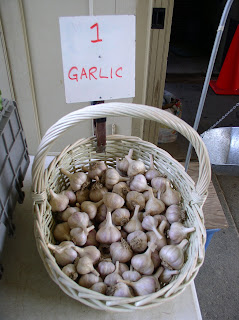 This morning we looked at the list of seeds & transplants we needed to get in the ground... fennel, swiss chard, lettuce, beets, carrots, beans, herbs, greens, radishes, turnips, cucumbers, summer squash. So we quickly divided up tasks & hopped on our tractors. We put all four of them to use this morning.
This morning we looked at the list of seeds & transplants we needed to get in the ground... fennel, swiss chard, lettuce, beets, carrots, beans, herbs, greens, radishes, turnips, cucumbers, summer squash. So we quickly divided up tasks & hopped on our tractors. We put all four of them to use this morning.  First I spread fertilizer across all the beds, then Nick chisel-plowed, meanwhile Dave was cultivating the neighboring rows. Then I hopped on the big John Deere & rototilled all the beds, followed closely by Nick who marked the beds for our big day of planting. Below is a picture of what the ground looks like after chisel-plowing (left) and after rototilling & marking (right):
First I spread fertilizer across all the beds, then Nick chisel-plowed, meanwhile Dave was cultivating the neighboring rows. Then I hopped on the big John Deere & rototilled all the beds, followed closely by Nick who marked the beds for our big day of planting. Below is a picture of what the ground looks like after chisel-plowing (left) and after rototilling & marking (right): We transplanted chard, lettuce, and fennel by hand, and used the push-seeder to direct seed everything else. Except the cucumbers & summer squash, which we put in the ground by hand too. We irrigated the transplants since it was a hot day, and covered up the greens, turnips, and radishes with ReeMay to protect them from flea beetles.
We transplanted chard, lettuce, and fennel by hand, and used the push-seeder to direct seed everything else. Except the cucumbers & summer squash, which we put in the ground by hand too. We irrigated the transplants since it was a hot day, and covered up the greens, turnips, and radishes with ReeMay to protect them from flea beetles. Thought I'd stick a sheep photo in:
Thought I'd stick a sheep photo in: Lately the sheep can't seem to get the idea of "uniform grazing"... they will eat some grass right down to the roots while leaving big patches of lush grass 8" tall. I assume they know what they're doing and there must be some good reason why they graze this way, but sometimes I doubt that. Anyway, my grand scheme of having a suburban sheep lawn-mowing company is quickly fading.
Lately the sheep can't seem to get the idea of "uniform grazing"... they will eat some grass right down to the roots while leaving big patches of lush grass 8" tall. I assume they know what they're doing and there must be some good reason why they graze this way, but sometimes I doubt that. Anyway, my grand scheme of having a suburban sheep lawn-mowing company is quickly fading.Here is the grand melon field:
 Can you spot the ripe cantelopes in there?
Can you spot the ripe cantelopes in there? Watermelons are a little more obvious to find. The trick is getting them ripe.
Watermelons are a little more obvious to find. The trick is getting them ripe. And the onions drying in the greenhouse...
And the onions drying in the greenhouse... We put a shadecloth over the top of the greenhouse to block some of the sun from scorching the onions, and the fans are left on to facilitate in the drying process.
We put a shadecloth over the top of the greenhouse to block some of the sun from scorching the onions, and the fans are left on to facilitate in the drying process.




















































